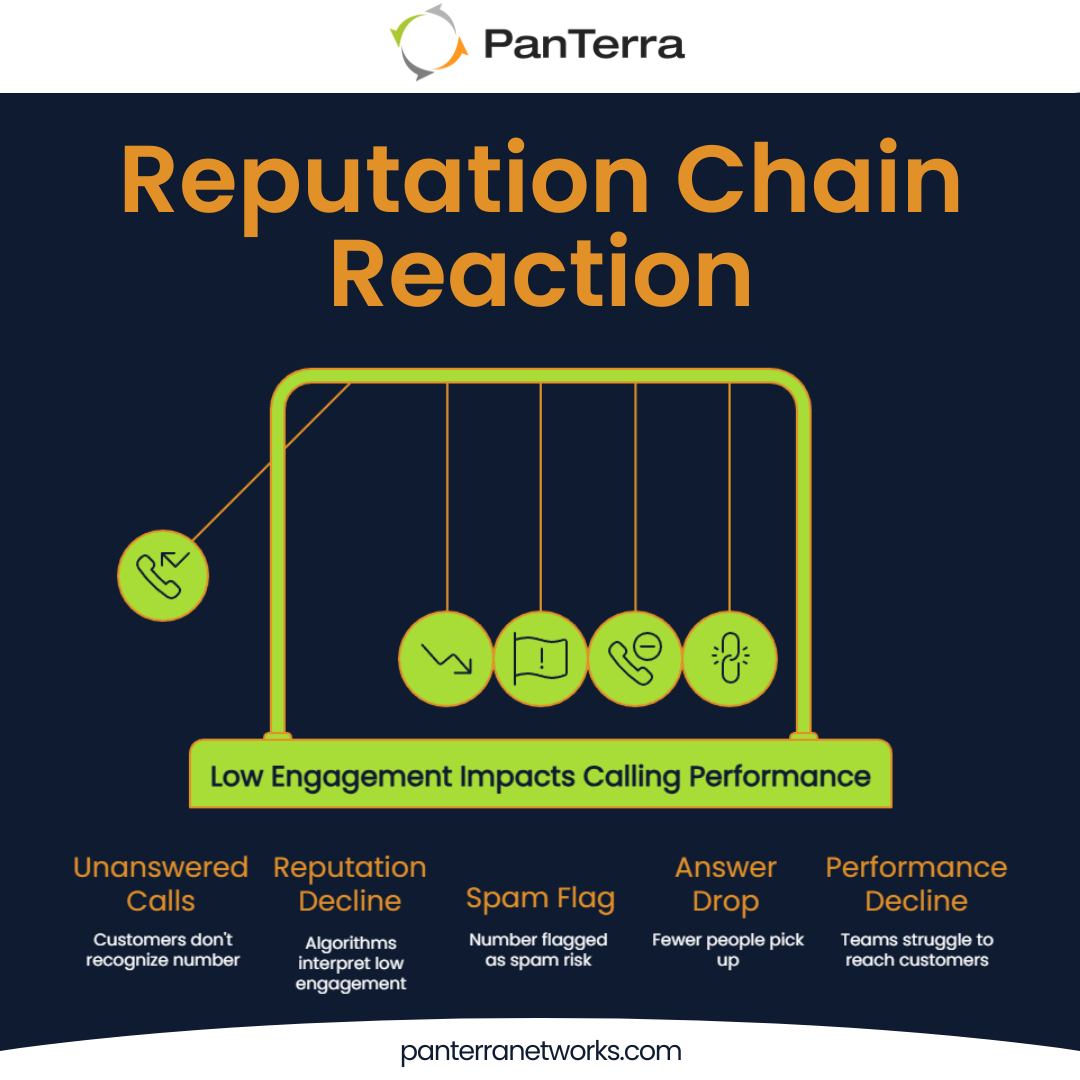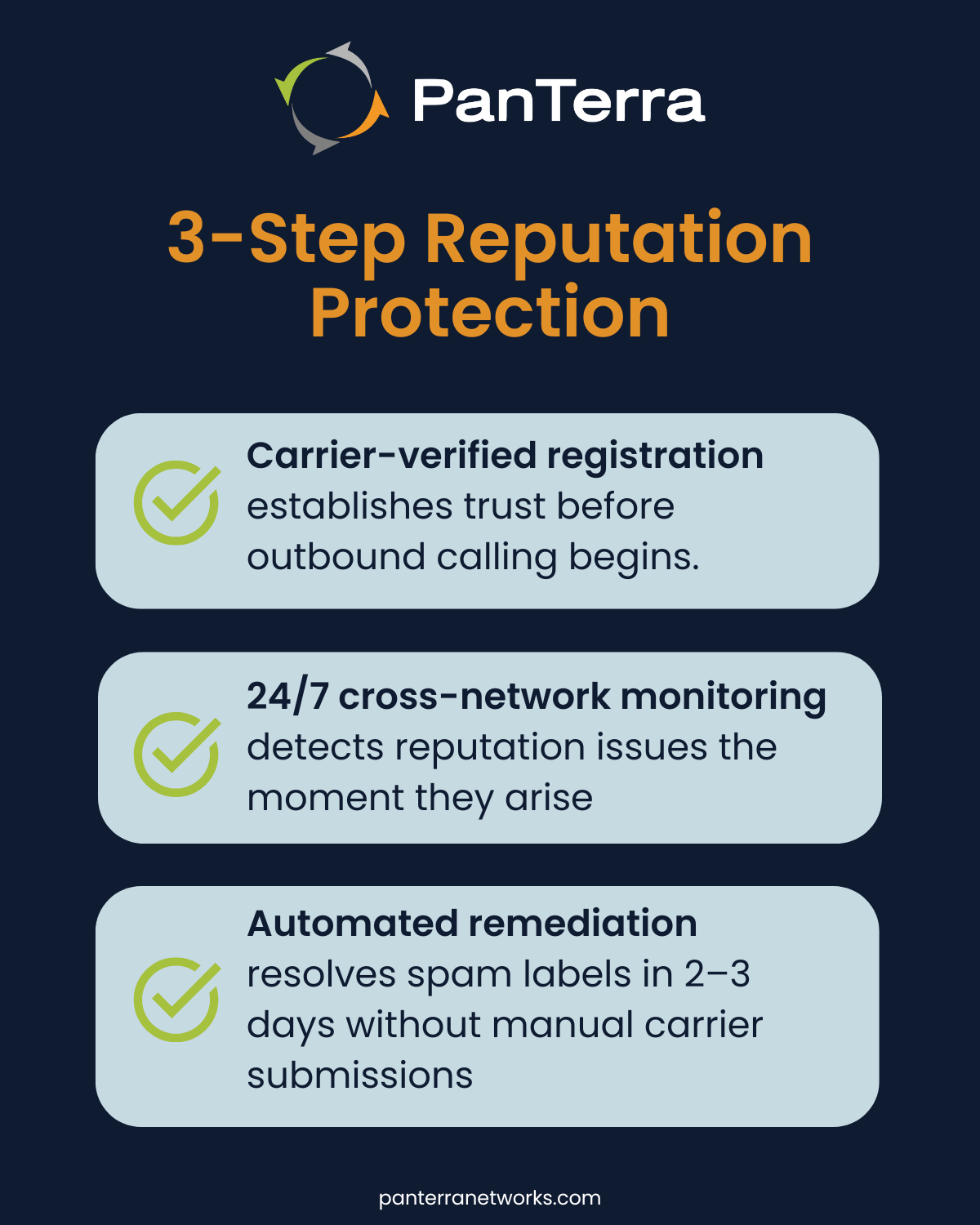Business Phone Reputation Management: All you need to know
November 21, 2025

Your business reputation lives everywhere: on Google reviews, social media comments, search results, customer forums, industry listings, and increasingly, in whether your phone calls appear as legitimate or as "Spam Likely."
Managing this multi-channel perception is now as essential as managing your operations or financial performance. Yet many businesses still treat reputation as something to worry about only when a crisis appears.
With 98% of consumers reading reviews and researching businesses online before making decisions, your reputation has become one of the most powerful drivers of trust, conversions, and long-term growth.
Navigate here:
- What Is Reputation Management?
- Why Does Reputation Management Matter for Your Business?
- What Types of Reputation Management Exist?
- How Do Algorithms Judge Your Calls?
- Why Legitimate Businesses Get Flagged?
- What's the True Business Impact of Spam Labels?
- How Does PanTerra Solve Phone Reputation Issues?
- Reputation Management FAQs
What Is Reputation Management?
Reputation management is the practice of monitoring, influencing, and protecting how your business is perceived across all channels—digital and traditional.
At its core, reputation management involves 3 interconnected activities: monitoring what's being said about your business, responding strategically to feedback and mentions, and proactively building positive assets that strengthen your brand.
It's about taking control of your narrative before others define it for you. Think of it as cultivating trust at scale, ensuring every interaction reinforces your value rather than undermining it.
The goal extends beyond managing crises to building accumulated trust that safeguards your business during difficult times while fueling expansion.
The scope has expanded dramatically in recent years. Twenty years ago, reputation meant word-of-mouth and Better Business Bureau ratings.
Ten years ago, it centered on Yelp and Google reviews. Today, it encompasses everything from TikTok videos and Reddit threads to LinkedIn thought leadership and whether your business phone is considered a Spam.
Consider what happens when someone researches your company. They might find Google reviews, social media posts, news articles, employee reviews on Glassdoor, discussions in online forums, and industry-specific review platforms.
Each touchpoint shapes perception. Meanwhile, when you call prospects or customers, carrier algorithms have already decided whether to display your number as legitimate or "Spam Likely"—a judgment that happens before any human interaction.
This complexity makes reputation management one of the most critical drivers of business performance in 2026, determining whether customers trust you, choose you, and stay with you.
Why Does Reputation Management Matter for Your Business?
Your reputation directly impacts revenue, but the financial impact extends far beyond pricing power and star ratings.
Trust determines whether customers choose you over alternatives. Poor reputation helps reduce conversions, but it also eliminates you from consideration entirely.
Reputation creates competitive advantages that compound over time. The business with better reviews attracts more customers, who leave more positive reviews, creating a virtuous cycle.
Meanwhile, competitors with poor reputation must spend increasingly more on marketing to overcome trust deficits, eroding margins while struggling to grow. For local businesses, that is even more relevant.
Strong reputation also improves operational efficiency. Customers who trust you require less convincing, accept recommendations readily, and forgive minor mistakes.
Sales cycles shorten, support interactions improve, and word-of-mouth amplifies every marketing dollar spent.
What Types of Reputation Management Exist?
Businesses manage reputation across multiple fronts, each requiring different strategies and tools.
Understanding these categories helps identify vulnerabilities and allocate resources effectively.
- Online Review Management: focuses on platforms like Google, G2, Facebook, and industry-specific sites where customers share experiences.
- Social Media Reputation: encompasses your brand presence across social platforms—not just what you post, but what others say about you.
- Search Engine Reputation: determines what appears when someone Googles your business. This goes beyond SEO to controlling the narrative across search results, ensuring positive content dominates while pushing down any negative mentions.
- Phone Number Reputation: has emerged as a critical category affecting every business making outbound calls. When carriers flag your numbers as spam, answer rates plummet 30-60%.
Among all these channels, one has emerged as both the most overlooked and the most operationally critical: your phone number reputation.
Unlike other reputation types that develop over months, phone reputation can deteriorate within days when numbers trigger spam algorithms.
While businesses heavily invest in managing reviews, social sentiment, and SEO, phone reputation silently determines whether customers even receive your calls.
And as call labeling algorithms have become more aggressive, this has turned into a high-risk operational vulnerability for every industry.
Why Has Phone Reputation Become an Operational Risk?
Phone reputation has shifted from a technical detail buried inside telecom infrastructure to a frontline operational risk.
Businesses across industries—from healthcare and finance to logistics and home services—are discovering that the reliability of their outbound communication affects revenue as directly as lead flow, staffing levels, or marketing spend.
Why Every Industry Is Feeling the Impact
Even organizations that don’t consider themselves “call-heavy” are starting to notice the impact.
A small clinic confirming ten appointments per day, a property manager conducting tenant outreach, or a regional service business coordinating technicians can all see significant disruption when calls stop connecting.
How Do Algorithms Judge Your Calls?
Every outbound call passes through multiple evaluation systems.
Carrier networks, analytics engines, and authentication protocols work together to score phone numbers and determine how calls appear to recipients.
A single issue in any layer can downgrade your reputation.
Why Scoring Varies Across Networks
Each major carrier maintains its own scoring model. As a result, your number may display normally on one network while appearing as “Spam Likely” on another.
This inconsistency creates confusion and worse, unpredictability. A sales rep might get through to one customer and be instantly blocked by another without realizing the discrepancy.
Behavioral Signals Are Interpreted Differently Everywhere
These inconsistencies stem from fundamental differences across carriers. Some weigh call velocity more heavily, others prioritize answer rates or consumer complaint data.
A pattern considered benign by one network may be treated as risky by another. This fragmented landscape makes reputation management inherently complex.
How Analytics Engines Influence Carrier Decisions
Third-party analytics engines add another layer to the process, analyzing cross-network calling patterns and providing recommendations to carriers.
These engines look for patterns that statistically correlate with spam behavior: unusual call bursts, repetitive dialing patterns, low engagement rates, or broad geographic reach.
When an analytics engine flags a number, carriers often adopt that classification, causing a spam label to propagate across networks in a matter of hours.
Why Authentication Alone Isn’t Enough
STIR/SHAKEN authentication was intended to curb spoofing, not to govern call legitimacy.
It confirms you're authorized to use the number, but it doesn’t override behavior-based analytics.
That means businesses can follow every rule correctly and still get labeled because their calling patterns resemble those of high-volume automated systems.
The net effect: your call reputation is shaped by data sources you don’t control, interpreted by algorithms you can’t see, and enforced through networks you can’t directly influence.
Why Legitimate Businesses Get Flagged
Once a business exceeds 50 outbound calls per day, automated systems increase scrutiny.
Completely normal business activities often resemble spam behavior:
- multiple attempts to reach customers
- short calls that end in voicemail
- clustered calling during business hours
- outbound calls across multiple states or time zones
- low answer rates caused by customer hesitation
For businesses with outreach cycles—sales follow-ups, appointment confirmations, recurring customer engagement—these patterns are unavoidable.
The answer-rate spiral
When people don’t pick up—because they don’t recognize the number or are simply busy—systems interpret this as evidence that calls are unwanted.
That lowers the score, which increases the likelihood of a spam label, which reduces answer rates even further.
Once the cycle begins, it can be difficult to reverse without direct remediation.
Inherited reputation problems
Phone numbers also inherit reputation issues from previous owners.
A newly assigned number might already be flagged, carrying baggage from past use that has nothing to do with your business.
Without monitoring, businesses may spend weeks assuming performance issues are internal, when in reality, customers simply never saw the calls.
Geographic dialing and volume triggers
National businesses, especially those with service areas in multiple states, inadvertently mirror patterns used by fraud operations.
Large bursts of outbound calls are common in sales teams, healthcare organizations, dispatch operations, and appointment-driven industries.
These legitimate patterns can trigger red flags when analyzed by machine-learning systems trained to reduce consumer spam complaints.
Behavior-based false positives
Some industries present unique challenges:
- Political campaigns experience sudden call volume spikes
- Utilities send urgent automated alerts
- Transportation companies conduct rapid routing calls
- Insurance agents place multiple follow-up attempts per claim
All of these can resemble spam behavior.
Simply put, algorithmic systems penalize normal business activity because they cannot contextualize intent.

What's the True Business Impact of Spam Labels?
The consequences are immediate and measurable. A 30–60% drop in answer rates eliminates revenue opportunities before conversations ever begin.
Sales teams lose access to prospects. Medical practices experience higher no-show rates. Service businesses can’t confirm visits. Collections departments struggle with aging receivables.
In many industries, the cost compounds.
Sales organizations
A team making 1,000 calls a week might typically achieve 200 answered calls at a 20% answer rate.
Spam labels cut that to 8–14%, leaving only 80–140 conversations. Those missing 60–120 conversations represent new business that never even had a chance to convert.
Sales leaders often assume performance issues stem from training, scripts, or lead quality. But the real problem is that prospects simply never saw the call.
Healthcare and service industries
Appointment-driven operations feel the impact immediately. When calls don’t connect, confirmations fall through.
That leads to gaps in the schedule, lost revenue, and lower patient satisfaction.
Even a small change in attendance rates can be expensive. For a mid-sized clinic, an increase in no-shows from 5% to 12% can translate into tens of thousands of dollars in monthly losses.
Customer service operations
Support callbacks fail to connect. Customers assume the business isn't responding, damaging trust, even though the business attempted to call.
In regulated industries, this can also create compliance concerns.
Collections and receivables
Each missed payment reminder extends days outstanding and strains cash flow.
For businesses operating on thin margins, this can materially affect liquidity.
Recruiting and staffing
Recruiters depend heavily on outbound calls. Spam labels erase contact points and reduce placement velocity.
Brand damage
When “Spam Likely” appears on a customer’s screen, trust erodes before the call is answered.
Support teams must spend time re-establishing credibility. Sales conversations begin defensively.
In competitive markets, this erosion of customer trust has long-term consequences.
This growing impact is why businesses are shifting to automated reputation management systems—tools that detect issues early and clear spam labels within 2–3 days, avoiding the multi-week manual cycles carriers rely on.
How Does PanTerra Solve Phone Reputation Issues?
PanTerra designed its reputation management system to address these challenges through automation and comprehensive protection.
The platform uses a simple three-step process to safeguard business communications.
1. Verified registration across carriers
Phone numbers are registered and verified across major carriers, creating a foundation of trust before outbound calling begins. This proactive step prevents many issues before they surface.
2. Continuous, cross-network monitoring
Reputation data is monitored 24/7 across AT&T, Verizon, T-Mobile, and key analytics engines. Instead of waiting for performance metrics or customer complaints, the system detects issues the moment they appear.
This monitoring includes behavioral patterns, answer-rate changes, call distribution anomalies, and feedback from analytics engines.
Early detection is critical—most businesses don’t realize they have an issue until performance metrics drop.
3. Automated, immediate remediation
If a spam label is detected, remediation begins instantly. Requests are submitted with complete documentation—no forms, no tickets, no manual steps.
Resolution times drop from 1–3 weeks to 2–3 business days, allowing teams to resume contact quickly.
The automation is persistent. The system follows up with carriers, validates completion, and ensures issues don’t recur across related numbers.

What Sets This Approach Apart
At $10 per number per month, this solution is approximately 40% lower than providers charging $15–20 for comparable services. But price is only one differentiator.
Key advantages:
- Automatic remediation instead of alert-only monitoring
- Integrated dashboard visibility inside the communications platform
- Full coverage across all major U.S. carriers and leading analytics engines
- Branded caller ID support for added recognition
- Dynamic voice routing, ensuring business continuity during remediation
- Expert assistance for complex or escalated cases
Many higher-priced alternatives focus primarily on monitoring. They alert businesses to issues but require manual remediation across carrier portals, increasing administrative overhead and leaving gaps in coverage.
Another differentiator is the ecosystem approach. Instead of treating spam labels as isolated events, the system analyzes patterns across your entire number inventory.
When one number experiences issues, the platform examines related lines to prevent cascading reputation problems.
How Quickly Can You Implement Protection?
Getting started is straightforward. Business verification and number registration typically complete within 24–48 hours. Monitoring begins immediately, and automated protection activates as soon as setup finishes.
Organizations making more than 50 daily outbound calls should implement reputation management proactively.
Clean numbers are significantly easier to protect than flagged numbers are to restore.
Even businesses already dealing with spam labels can see improvements quickly. Automated remediation restores flagged numbers and strengthens protection across the entire number inventory.
For multi-location operations or teams with distributed workforces, centralized monitoring ensures consistency.
Whether calls originate from a call center, remote employees, or multiple offices, reputation management treats the number inventory as a unified operational asset.
Why Is Phone Reputation No Longer Optional?
Every day without reputation management increases the risk of numbers being flagged.
Once spam labels appear, the impact goes far beyond missed calls: revenue is lost, appointments fail, and customers assume you never attempted to reach them.
At $10 per number monthly, businesses gain automated monitoring and remediation that prevents issues before they interrupt operations.
Even when problems arise, they’re resolved within 2–3 days, not weeks.
The organizations that thrive in 2026 will be those that ensure their outbound communication remains reliable.
Phone reputation has become a form of digital infrastructure:silent when it works, painful when it doesn’t. Protecting it is no longer optional.
Talk to a PanTerra specialist to audit your current phone reputation and see how many calls you’re losing to spam labels
Reputation Management Frequently Asked Questions
How long does it take to clear a spam label?
Most labels are resolved within 2–3 business days, compared to 1–3 weeks through manual carrier remediation.
What if my number is already flagged?
Existing spam labels can be remediated. The system initiates correction immediately and strengthens protections to reduce recurrence.
Which carriers and analytics engines are monitored?
Coverage includes AT&T, Verizon, T-Mobile, and major analytics providers that influence call scoring.
Can multiple phone numbers be monitored?
Yes. The system can protect a single line or an entire portfolio across multiple locations.
Do you offer branded caller ID?
Yes. Branded caller ID helps your business name appear instead of just your phone number.
.jpg?width=500&height=500&name=Are%20you%20Getting%20a%20Good%20Deal%20(1).jpg)
Comments